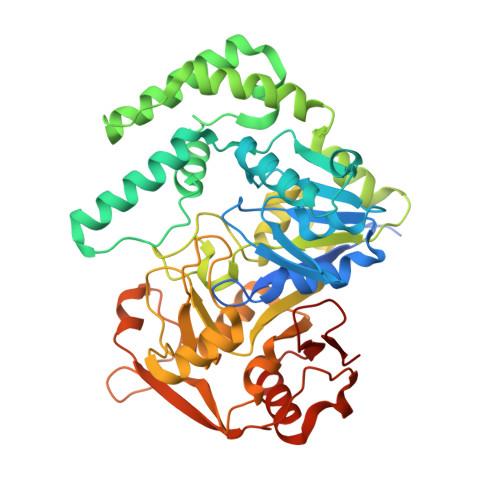Cavitation as a mechanism of substrate discrimination by adenylosuccinate synthetases.
Iancu, C.V., Zhou, Y., Borza, T., Fromm, H.J., Honzatko, R.B.(2006) Biochemistry 45: 11703-11711
- PubMed: 16981730
- DOI: https://doi.org/10.1021/bi0607498
- Primary Citation of Related Structures:
2DGN, 2GCQ - PubMed Abstract:
Adenylosuccinate synthetase catalyzes the first committed step in the de novo biosynthesis of AMP, coupling L-aspartate and IMP to form adenylosuccinate. Km values of IMP and 2'-deoxy-IMP are nearly identical with each substrate supporting comparable maximal velocities. Nonetheless, the Km value for L-aspartate and the Ki value for hadacidin (a competitive inhibitor with respect to L-aspartate) are 29-57-fold lower in the presence of IMP than in the presence of 2'-deoxy-IMP. Crystal structures of the synthetase ligated with hadacidin, GDP, and either 6-phosphoryl-IMP or 2'-deoxy-6-phosphoryl-IMP are identical except for the presence of a cavity normally occupied by the 2'-hydroxyl group of IMP. In the presence of 6-phosphoryl-IMP and GDP (hadacidin absent), the L-aspartate pocket can retain its fully ligated conformation, forming hydrogen bonds between the 2'-hydroxyl group of IMP and sequence-invariant residues. In the presence of 2'-deoxy-6-phosphoryl-IMP and GDP, however, the L-aspartate pocket is poorly ordered. The absence of the 2'-hydroxyl group of the deoxyribonucleotide may destabilize binding of the ligand to the L-aspartate pocket by disrupting hydrogen bonds that maintain a favorable protein conformation and by the introduction of a cavity into the fully ligated active site. At an approximate energy cost of 2.2 kcal/mol, the unfavorable thermodynamics of cavity formation may be the major factor in destabilizing ligands at the L-aspartate pocket.
Organizational Affiliation:
Department of Biochemistry, Biophysics, and Molecular Biology, Iowa State University, Ames, Iowa 50011, USA.

















